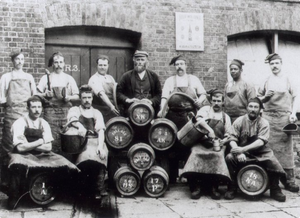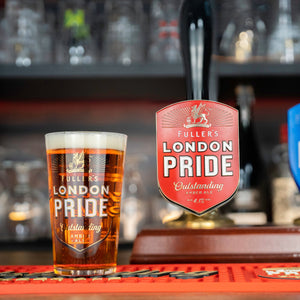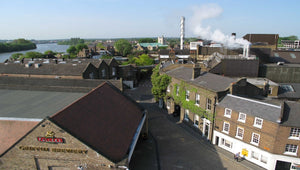Our Story
A story that's been brewing for some time. Immortalised in the name of one of our famous ales, 1845 is a year that will forever be Fuller's. It was then that the partnership papers of Fuller, Smith & Turner were officially signed, marking the start of something special for London's brewery scene.

Our Heritage
The Fuller's Griffin Brewery is a special place. Not just to us, but to anyone who has ever enjoyed a pint of Pride. It's where the magic happens, where the malt meets the hops.

1845 - Our Beginnings
Beer has been made in this part of the capital for more than 350 years, dating back to the era of Oliver Cromwell. Back then, it was quite common for large households to brew their own beer. In the late 1600s, one such private brewhouse was in the gardens of Bedford House on Chiswick Mall. Another, a far humbler concern, was operating nearby at the cottage of Thomas Urlin.
When Urlin died, the property passed to his widow and son-in-law, a gentleman named Thomas Mawson, who stepped in to take up the reigns as manager. It was he who laid the foundations for a major brewing enterprise – buying The George public house and two adjoining cottages for £70, then later snapping up the brewhouse on Bedford House too.

The Griffin is born
The next notable owners of the brewery were John Thompson and David Roberts, whose six-year partnership suffered due to a series of legal wranglings. The duo predictably parted company in 1786 when Roberts left to join the Royal Household and Thompson soldiered on alone.
Eventually, the brewery passed to his sons, Douglas and Henry. It was under their stewardship in 1816 that the brewery first acquired the Griffin name and emblem. The Griffin had previously been the symbol of Meux and Reid's Brewery in the aptly-named Liquorpond Street, but when that business collapsed, the Thompson brothers moved swiftly to snaffle the name.
The adoption of the Griffin is a decision that's certainly stood the test of time, but other decisions by the pair were far less successful. Double dealings pertaining to mortgages led the brothers – and the brewery – to the brink of ruin. They needed investment, and fast

Fuller, Smith and Turner
The Thompson brothers invited Philip Wood, brother of London's Lord Mayor, into the partnership, but Wood knew his money alone couldn't save the brewery. He too looked elsewhere for help. It came from one John Fuller.
Fuller was a wealthy country gentleman and he jumped at the chance to come aboard, investing primarily on behalf of his son. He soon bought one of the Thompsons out and, within a couple of years, found himself the majority shareholder at the brewery.
In 1839, John Fuller died and passed control to his son, John Bird Fuller. The younger Fuller moved quickly to make his mark, and by 1845 he'd severed ties with the Thompsons to take the reins by himself.
He sought investment and expertise from third parties though, and John Smith – already helping to run a successful brewery elsewhere – was invited aboard. He invested on behalf of his son, Henry Smith, and his son-in-law, John Turner.
So it was that Fuller, Smith & Turner came into being

setting the standard
Following incorporation, a wave of acclaimed ales came out of the brewery. Chiswick Bitter arrived on the scene in 1930. Into the '50s, London Pride took centre stage. Then, in 1971, ESB was launched. In 1979 with the help of Thames America, we exported to the USA for the first time. In 1997 our first Vintage Ale was launched using the finest ingredients available which has continued to be our philosophy to this day
Awards started flowing as freely as the beer and we soon became the first brewery to win the CAMRA Champion Beer of Britain award with three separate brews.

The story continues
That's far from the end of the story though, as we continue to invest and to innovate, building on our history and heritage to set new benchmarks for brewing and retailing as part of Asahi UK Ltd.
We have a great amount of Pride in our rich history – but there's plenty in our future too.



